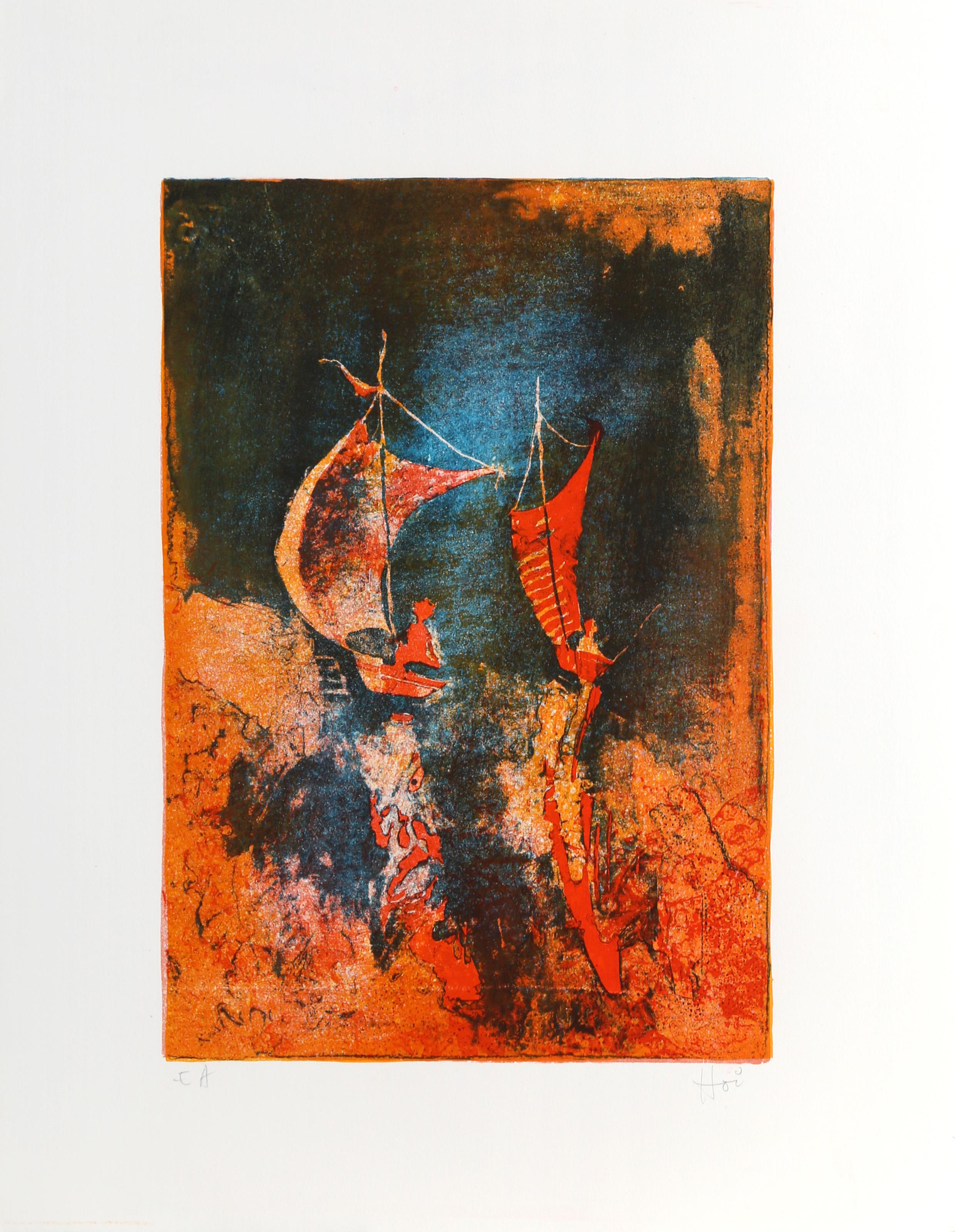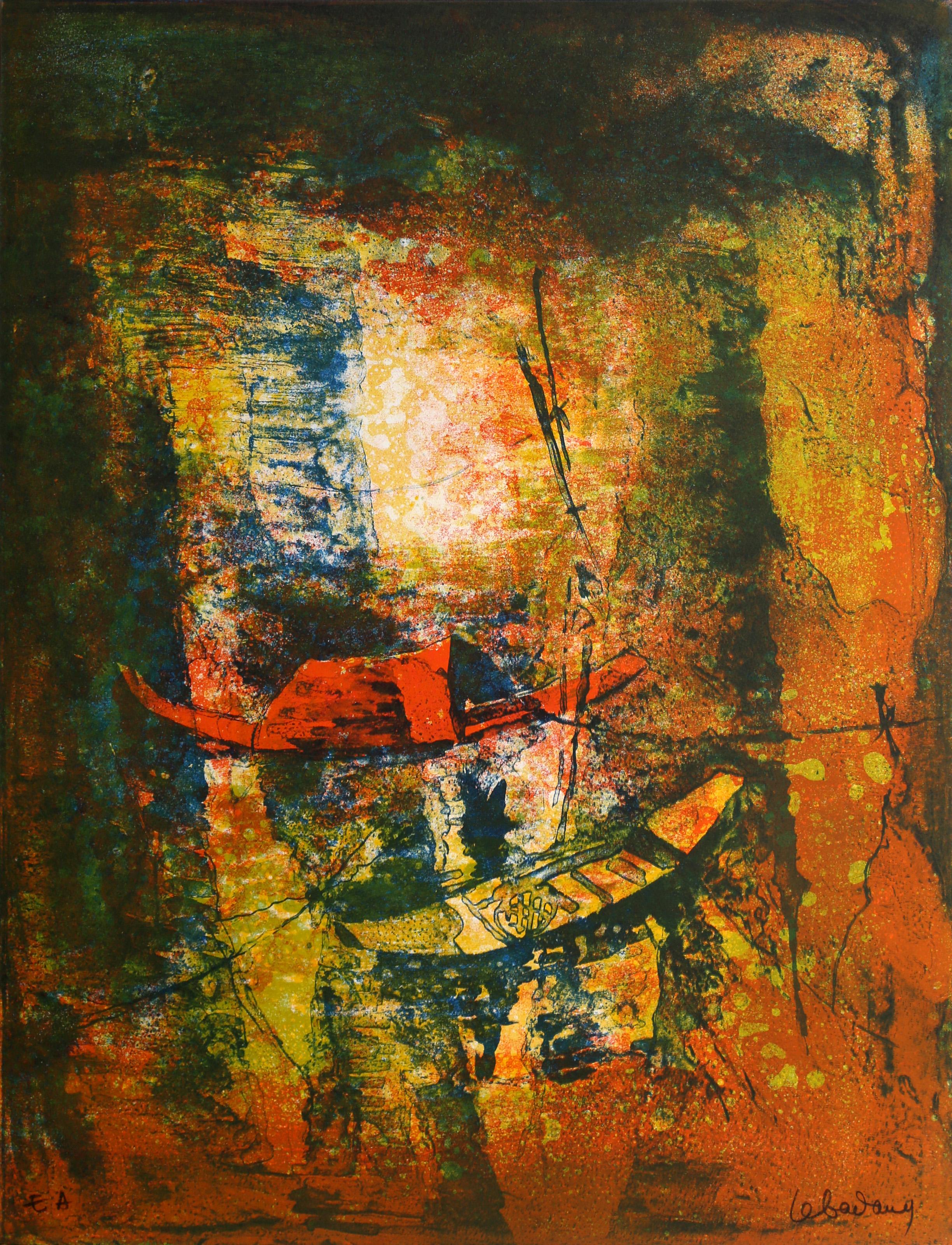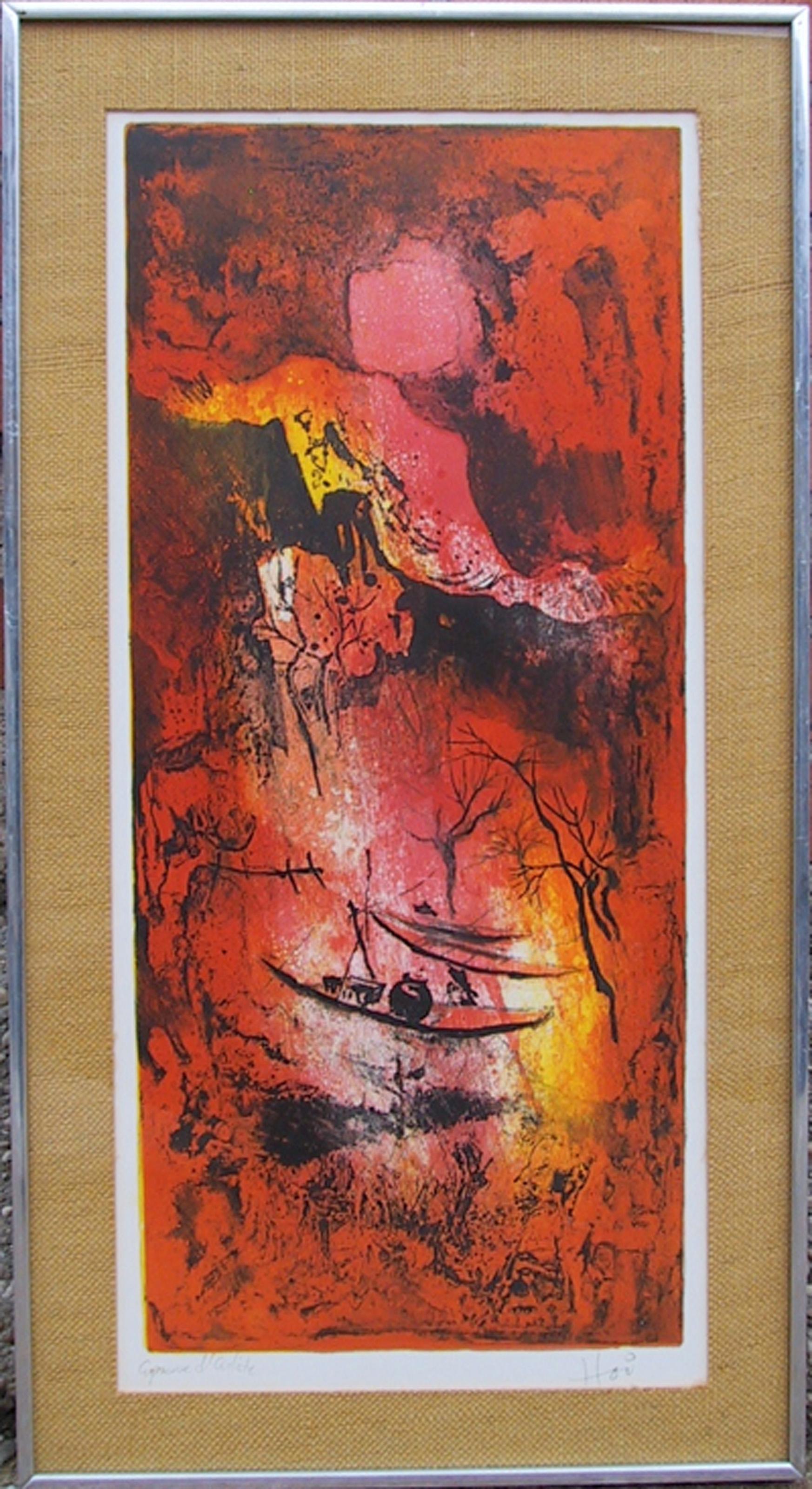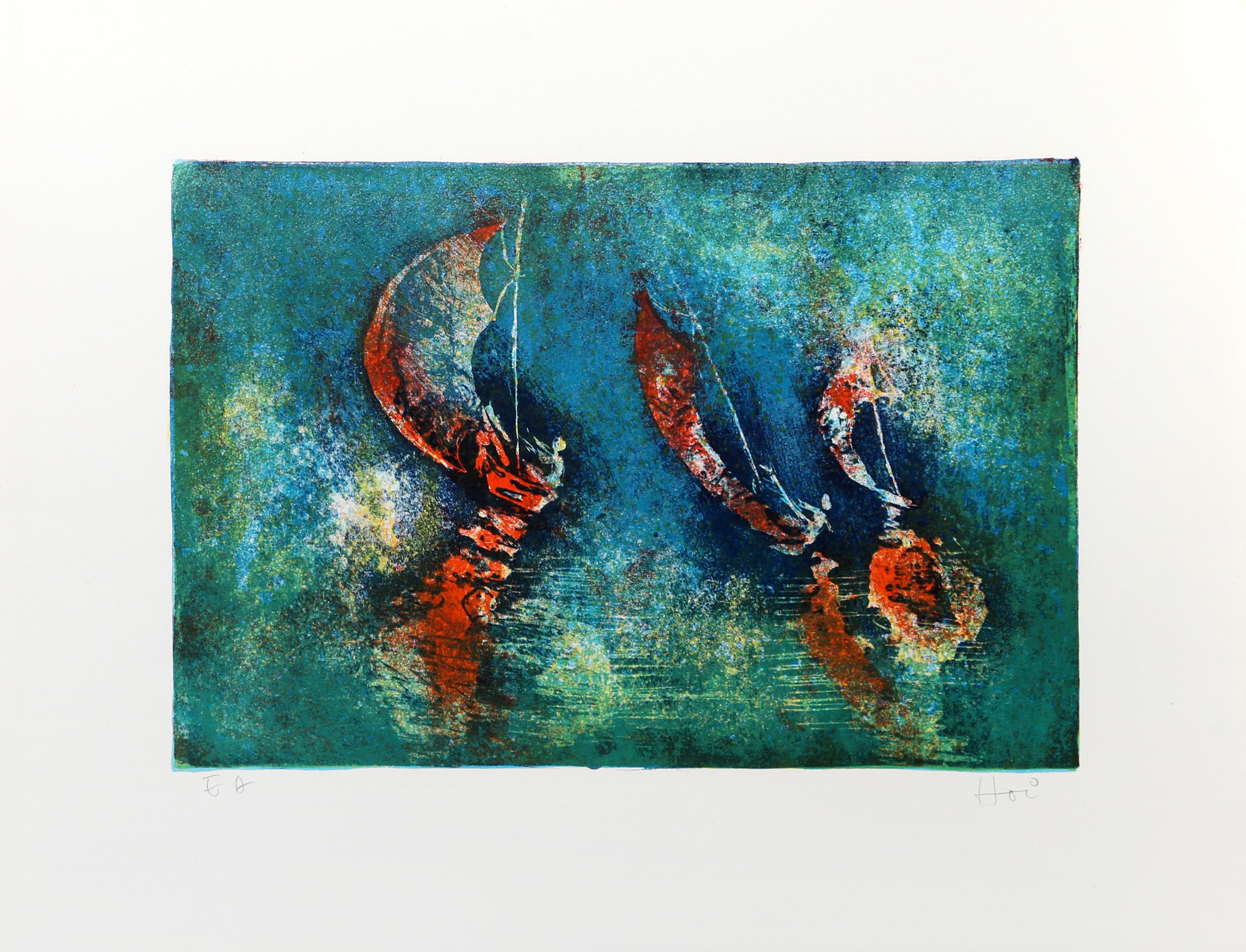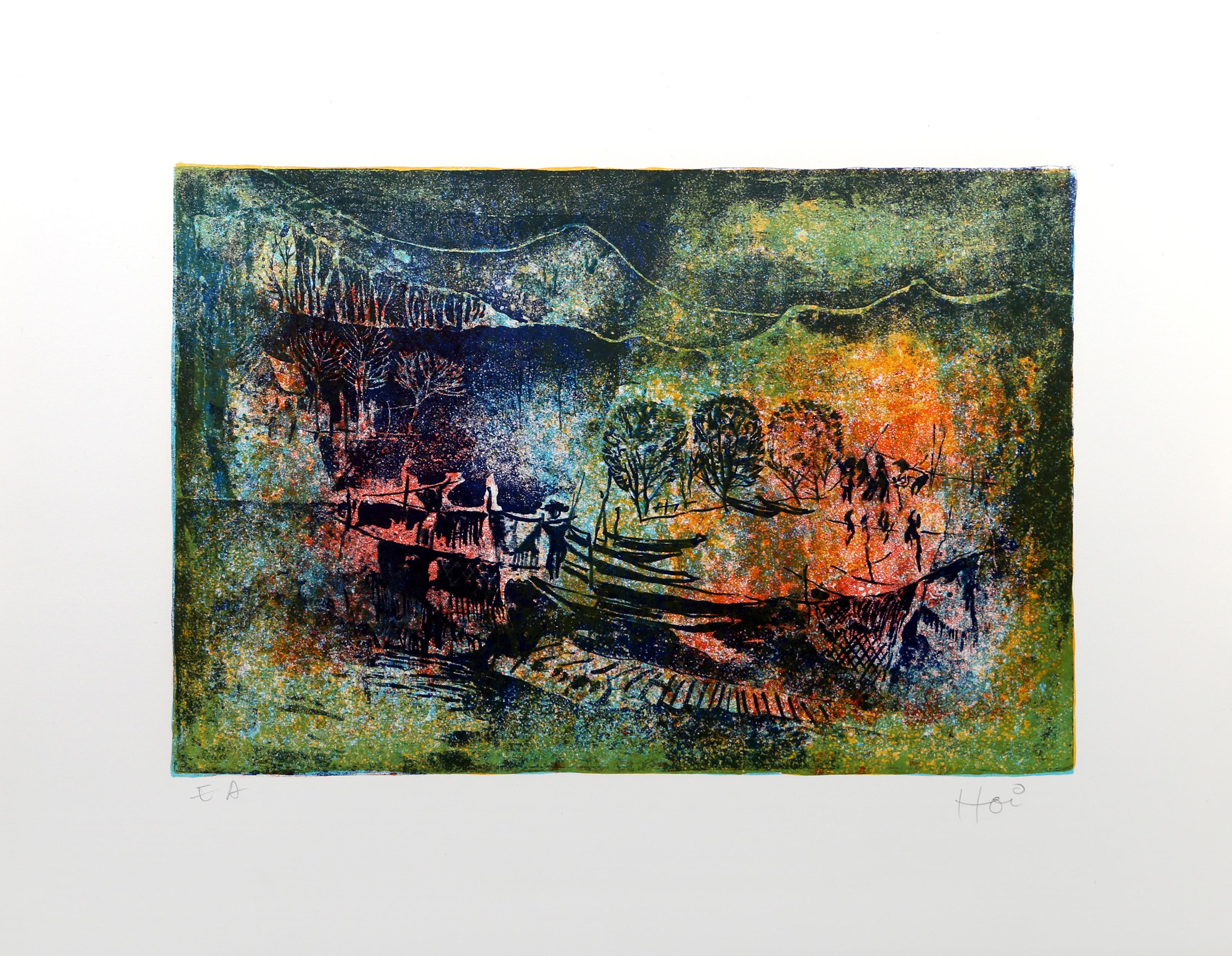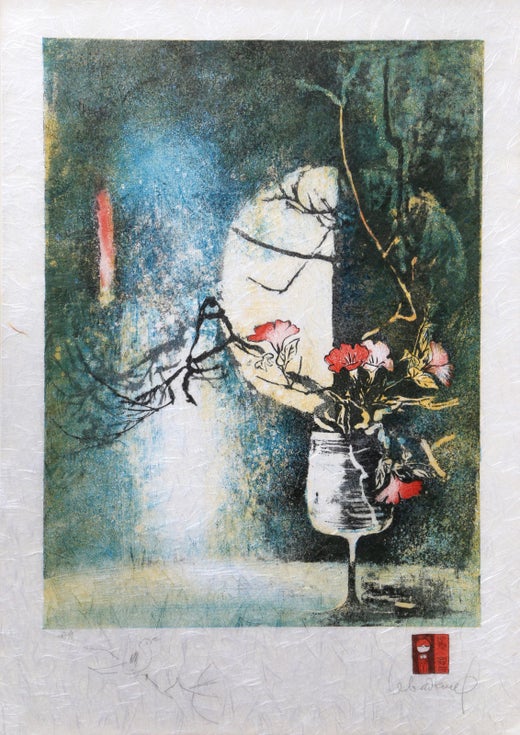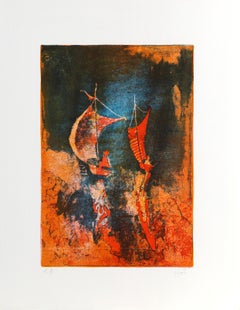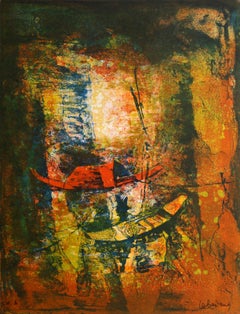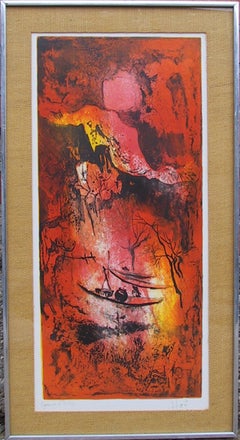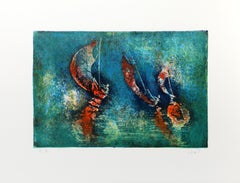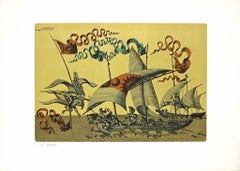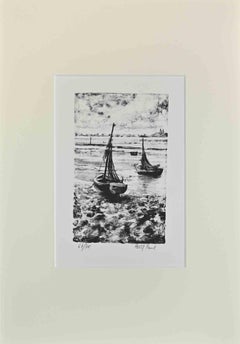Items Similar to Boat Race, Lithograph by Hoi Lebadang
Want more images or videos?
Request additional images or videos from the seller
1 of 5
Hoi LebadangBoat Race, Lithograph by Hoi Lebadangcirca 1970
circa 1970
$750
£581.69
€659.32
CA$1,073.38
A$1,172.89
CHF 608.06
MX$14,011.81
NOK 7,737.99
SEK 7,244.59
DKK 4,923.31
About the Item
Lebadang (aka Hoi), Vietnamese (1922 - 2015) - Boat Race. Year: circa 1970, Medium: Lithograph with Remarque Drawing, signed in pencil, Edition: EA, Size: 21 x 29 in. (53.34 x 73.66 cm)
- Creator:Hoi Lebadang (1922 - 2015, Vietnamese)
- Creation Year:circa 1970
- Dimensions:Height: 21 in (53.34 cm)Width: 29 in (73.66 cm)
- Medium:
- Movement & Style:
- Period:
- Framing:Framing Options Available
- Condition:
- Gallery Location:Long Island City, NY
- Reference Number:Seller: 690141stDibs: LU46614405952
Hoi Lebadang
Lebadang was born in 1921 in Bich-La-Dong, a village along the Huong River in Quang-Tri Province of Hue, Vietnam. He expressed himself through a variety of media, including painting, watercolor, sculpture, jewelry and graphic works. He often combined various media, creating sculptural, highly textured artwork. “Life is a sinking ship and work is a lifeboat.” This described her husband perfectly.
He lived in Paris since 1939, studying at the École des Beaux-Arts in Toulouse for six years until his first one-man show in 1950. He created large-scale abstract oil paintings with vivid blues and glowing puddles of orange and red. Painting and printmaking were Lebadang’s most frequently used media but he also worked in terra cotta and a variety of other media, such as “Vessel” (1994). Whatever he created, each piece spoke to the entangled roles of man and nature. In his 1981 “La Comédie Humaine,” he wrote: “In my work, I use the circle, the magic symbol of life, to enclose reliefs and landscapes. It symbolizes that nature is inseparable from man. Man finds sustenance and spiritual nourishment in every source.” And while the human form was not represented figuratively in his work until the late 1970s, he confirmed that man was always present.. His oil paintings of the ’60s are ambiguous at first glance, yet the faint outlines of boats, bridges, and horses gently float to the top. After his shift in style, bringing definition to his paintings, these dreams were made more lucid. Many of his figures become emotive and highly dramatic, this time with visible faces. . Mixing media, he painted aerial scenes of mountains and oceans where the viewer was stationed in the heavens. These paintings elaborated on man’s relationship to the natural world, continuously presented as a flurry of memories. Memories—objects that haunt the entire oeuvre of the artist—are a familiar subject to Lebadang. “Art, in all its forms, whether literature, philosophy, or the visual arts, expresses an attempt to understand the riddle of life and helps lessen the fear of death,” he wrote. His work is exhibited in many public and private collections, including the Cincinnati Museum of Art in Ohio, the Phoenix Art Museum in Arizona, the Rockefeller Collection in New York, the Foundation Museum in Kenya, the Lund University Museum in Sweden, the Loo Collection in Tokyo, and the Museum of Arts and Letters in France. Lebadang was honored with numerous awards and accolades during his career. He also designed an award for the International Institute of St. Louis. The Lebadang Award is presented biannually to an individual who has demonstrated extraordinary volunteer service. The award program was established by the institute in 1989 to recognize organizations and individuals who exemplify “Peace within you, your country, and the world.” “My artwork is often strange but simple,” Lebadang once said. “So everyone can hopefully feel happy and relaxed, and that’s why they like them.”
About the Seller
4.9
Platinum Seller
Premium sellers with a 4.7+ rating and 24-hour response times
Established in 1979
1stDibs seller since 2014
3,169 sales on 1stDibs
Typical response time: 1 hour
- ShippingRetrieving quote...Shipping from: Long Island City, NY
- Return Policy
More From This Seller
View AllRiver Scene 2, Colorful Abstract Lithograph by Hoi Lebadang
By Hoi Lebadang
Located in Long Island City, NY
Lebadang (aka Hoi), Vietnamese (1922 - 2015) - River Scene 2. Medium: Lithograph on Rives BFK, signed "Hoi" and numbered in pencil, Edition: E.A., Image Size: 18 x 12.5 inches, Size...
Category
1970s Abstract Prints and Multiples
Materials
Lithograph
Boats by the Shore, Lithograph by Hoi Lebadang
By Hoi Lebadang
Located in Long Island City, NY
Lebadang (aka Hoi), Vietnamese (1922 - 2015) - Boats by the Shore. Medium: Lithograph, signed and numbered in pencil, Edition: E.A., Size: 25.5 x 19.5 in. (64.77 x 49.53 cm), Descri...
Category
1970s Abstract Prints and Multiples
Materials
Lithograph
Boats at Dock, Lithograph by Hoi Lebadang
By Hoi Lebadang
Located in Long Island City, NY
Lebadang (aka Hoi), Vietnamese (1922 - 2015) - Boats at Dock. Year: circa 1975, Medium: Lithograph, signed Hoi, Edition: EA, Size: 26 x 12 in. (66.04 x 30.48 cm), Frame Size: 32 x...
Category
1970s Abstract Prints and Multiples
Materials
Lithograph
River Scene 2, Lithograph by Hoi Lebadang
By Hoi Lebadang
Located in Long Island City, NY
Lebadang (aka Hoi), Vietnamese (1922 - 2015) - River Scene 2. Medium: Lithograph on Rives BFK, signed "Hoi" and numbered in pencil, Edition: E.A., Image Size: 18 x 12.5 12.5 x 18 in...
Category
1970s Abstract Prints and Multiples
Materials
Lithograph
Boats Along River, Etching with Aquatint by Hoi Lebadang
By Hoi Lebadang
Located in Long Island City, NY
Lebadang (aka Hoi), Vietnamese (1922 - 2015) - Boats Along River. Medium: Etching with Aquatint, signed Hoi and numbered in pencil, Edition: 227/275, Image Size: 25 x 11 inches, Fra...
Category
1980s Abstract Prints and Multiples
Materials
Etching
Docked Boats 5, Abstract Expressionist Lithograph by Hoi Lebadang
By Hoi Lebadang
Located in Long Island City, NY
Lebadang (aka Hoi), Vietnamese (1922 - 2015) - Docked Boats 5. Medium: Lithograph on Rives BFK, signed "Hoi" and numbered in pencil, Edition: E.A., Image Size: 12.25 x 18.5 inches, ...
Category
1970s Abstract Prints and Multiples
Materials
Lithograph
You May Also Like
Boats - Etching by Gaetano Pompa - 1970s
By Gaetano Pompa
Located in Roma, IT
Boats is an original artwork realized by Gaetano Pompa (1933, Forenza- 1998) in the 1970s.
The artwork was completed by hand watercoloring.
The work is...
Category
1970s Modern Figurative Prints
Materials
Etching
Fishing Boats in Cap Muroto
Located in San Francisco, CA
This artwork Titled "Fishing Boats in Cap Muroto" c.1950, is an original woodcut on paper by Japanese artist Gihachiro Okuyama, 1907-1981. It is hand signed and inscribed in Japanese...
Category
Mid-20th Century Modern Landscape Prints
Materials
Woodcut
Landscape by Moonlight, Barges in Vietnam lithograph by Vietnamese Master
By Dang Lebadong
Located in Norwich, GB
Wonderful original original artist's proof lithograph by Vietnamese/French Master Dang Lebadang. Marked EA (for "Epreuve d'Artiste" lower left, signed lo...
Category
1960s Abstract Impressionist Landscape Prints
Materials
Lithograph
Boats - Lithograph by Paul Petit - Mid 20th Century
Located in Roma, IT
Boats is a lithograph realized by Paul Petit in the mid-20th Century.
Hand-signed.
Numbered, 67/75
The artwork is depicted through confident strokes in a well-balanced composition.
Category
Mid-20th Century Modern Landscape Prints
Materials
Lithograph
Seascape with Boats - Original Lithograph by Paul Petit - Mid 20th Century
Located in Roma, IT
Seascape with Boatsis an original lithograph realized by Paul Petit in the mid-20th.
Hand-signed.
Numbered. Edition, 16/50.
The artwork is depicted throu...
Category
Mid-20th Century Modern Landscape Prints
Materials
Lithograph
Boat, Mixed Media on Paper Color by Dhiraj Chowdhuri "In Stock"
By Dhiraj Chowdhury
Located in Kolkata, West Bengal
Dhiraj Chowdhury - Boat - 14.5 x 22, inches (unframed size)
Mixed Media on Paper, 2014
( Framed & Delivered )
In this evocative mixed media work, Dhiraj Choudhury captures the still...
Category
2010s Modern Landscape Paintings
Materials
Paper, Mixed Media
Read More
Romare Bearden’s Humanity Infuses His Bright, Bold Art
Through collage, painting and printmaking, the artist foregrounded Black life in America in revolutionary new ways.
Chryssa’s 1962 Neon Sculpture Was Way ahead of the Art-World Curve
By working with lettering, neon and Pop imagery, Chryssa pioneered several postmodern themes at a time when most male artists detested commercial mediums.
More Ways To Browse
Folk Art Boat
Bucking Horse
Carlo Pellegrini
Chagall Jacob
Chagall Jerusalem Windows
Charles White Artist
Chartres Cathedral
Christmas Lithograph
Cote D Azur Vintage Posters
Cote D Azur Vintage Travel Poster
Craig Martin
Curtis Engraving
Dali 1977
Jim Dine Poster
La Revue Blanche
Matador And Bull
Maurice Utrillo Montmartre
Max Jaffe
